Who Did Aaron Burr Run for President Again
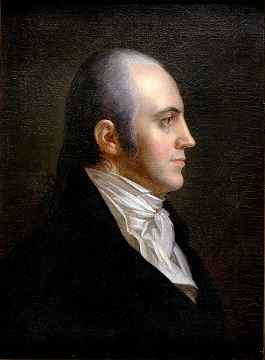
Portrait of Aaron Burr
John Vanderlyn, 1802
Aaron Burr was born in 1756 in Newark, New Jersey. He was the son of Aaron Burr, Sr. — the 2d president of Princeton, and was the grandson of Jonathan Edwards. He graduated at 16 from the College of New Jersey every bit a student of theology, just afterward switched his career track to study constabulary.
Burr began his military service as a volunteer effectually 1775, and served during Bridegroom Arnold'due south "March to Quebec" [September 13 — Nov 9, 1775]. He is credited with trying to evacuate the body of General Richard Montgomery afterward he was killed in activity during the invasion. Burr joined the staff of George Washington in 1776 and was called to New York City. He and Full general Washington manifestly did not go along and he left a few weeks afterward. On June 22 he became an aide-de-camp to General State of israel Putnam, somewhen seeing action in the Boxing of Long Island and the evacuation of New York City. He was commissioned Lieutenant Colonel of Malcolm's Regiment on January 4, 1777. He was stationed at Orange County, New York, substantially the commander of the regiment at the age of 21
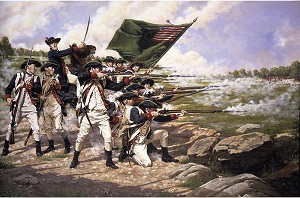
The Delaware Regiment at the Battle of Long Island.
Domenick D'Andrea, 1776
He spent the winter of 1777-1778 at Valley Forge where he was almost involved with the Conway Cabal. After evacuating with the regular army on June xix, 1778, he commanded a brigade during Monmouth. After the action there, he openly supported General Charles Lee — whom Washington had reprimanded upon finding him retreating from battle. Burr commanded his regiment following the Monmouth Campaign in Westchester County, New York.
Aaron Burr resigned on March 3, 1779 citing ill health. By the autumn of the post-obit year, he resumed his career equally a educatee of law. In 1782, he married Mrs. Theodosia Bartow Prevost, the widow of a British officer who was also ten years older than him. They had one girl, Theodosia, in 1783, who later on died at sea in 1813. Aaron Burr and his wife were married for twelve years, when she passed away.
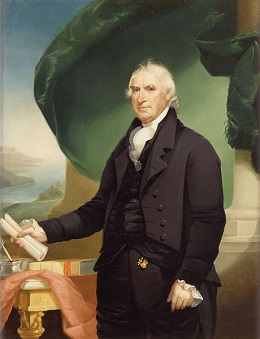
George Clinton
Burr was a very successful attorney. He moved to New York in 1783 and shared a practice with Alexander Hamilton. In 1789, New York Governor, George Clinton named him Attorney Full general, launching his political career. He was elected a U.S. senator in 1791, defeating incumbent Full general Philip Shuyler, who happened to be the father-in-law of Alexander Hamilton, which may well take contributed to the enmity between the 2 men, which was to later culminate in their famous duel.
After 1 half-dozen-year term in the Senate, Burr ran for president in 1796 and over again in 1800. Dorsum then, a candidate for president did not campaign alongside a running-mate, who would serve equally his vice-president if elected. Instead, each elector could bandage ii votes for any ii candidates in the race, and whoever received the near votes became president, provided he received a bulk, while the runner-up became vice-president, fifty-fifty if they were from opposing political parties.
Burr came in fourth in 1796. John Adams was elected president, with Jefferson as Vice-President. By 1800, Adams' popularity had waned, as did support for his Federalist Party. This was the first election in which each party nominated a "ticket," with one candidate for president and another for vice-president, although the rules would non change until 1804 with the passage of the twelfth Amendment, which decreed that electors would vote for the offices pf president and vice-president seperately. Jefferson and Burr, both members of the opposition Autonomous-Republican party, tied for kickoff place with 73 electoral votes each. The tie was broken past the House of Representatives, which selected Jefferson as President, Burr as Vice President.
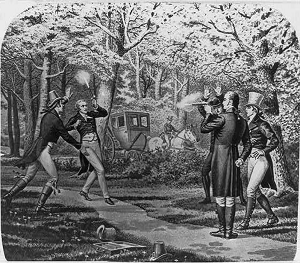
The Burr and Hamilton duel, eleven July, 1804, at Weehawken, Due north.J.
from a 19th century print
In 1804, Burr ran for governor of New York, merely lost by a large margin to Morgan Lewis. This, along with other setbacks, he blamed on Alexander Hamilton'southward political machinations. On July 11, 1804 — Burr and Hamilton met at 10 paces at Weehawken. Both fired and Hamilton fell, mortally wounded. As far equally history records, this is the only time a sitting vice-president shot and killed someone while in office. Burr continued to serve the reminder of his term as vice-president until March of 1805.
Burr later was charged with treason in a conspiracy regarding capitalization on a possible state of war with Spain. He eventually was acquitted later a trial in 1807. He sailed to England in 1808 hoping to proceeds back up for a revolution in United mexican states. He was ordered out of the land and traveled in Europe to Sweden, Denmark, Federal republic of germany and Paris. There he tried to garner support from Napoleon. This failed, leaving him and so penniless he couldn't even travel home. He eventually sailed by French ship in 1811 but it was captured by the British and he was detained in England until May 1812. He finally returned to the United States to pursue his law practice back in New York.
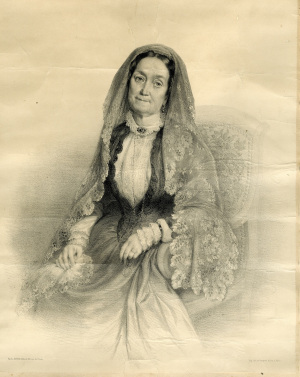
1852 Lithograph of Eliza Jumel
In 1833, he married over again, this time to the widow of Stephen Jumel. When she realized her fortune was dwindling from her hubby'south country speculation, they separated later on only four months. During the month of their kickoff anniversary, she sued for divorce which was granted the day he died: September 14, 1836.
Courtesy National Center for the American Revolution/Valley Forge Historical Society
frankstimperall88.blogspot.com
Source: https://www.ushistory.org/valleyforge/served/burr.html
Post a Comment for "Who Did Aaron Burr Run for President Again"